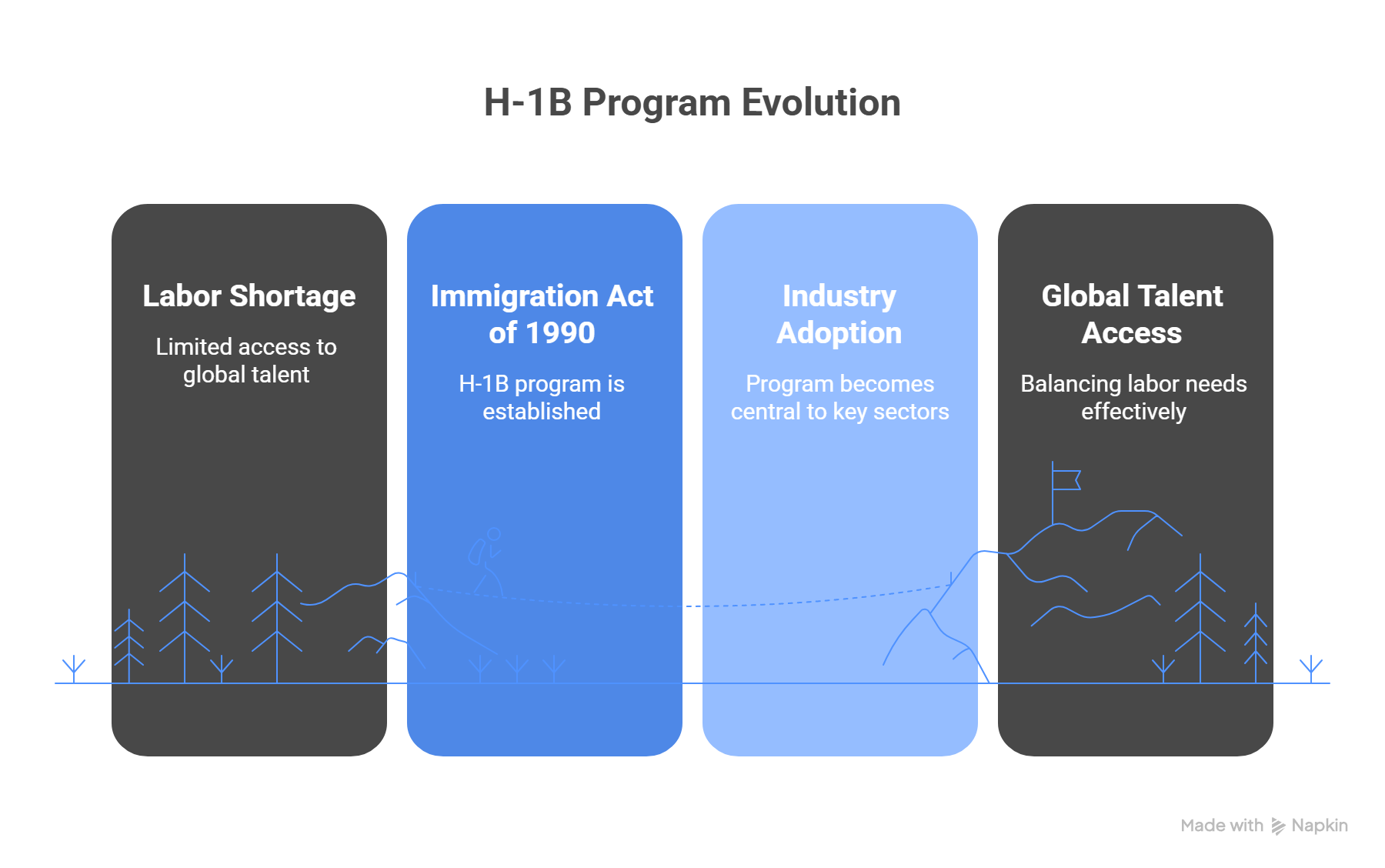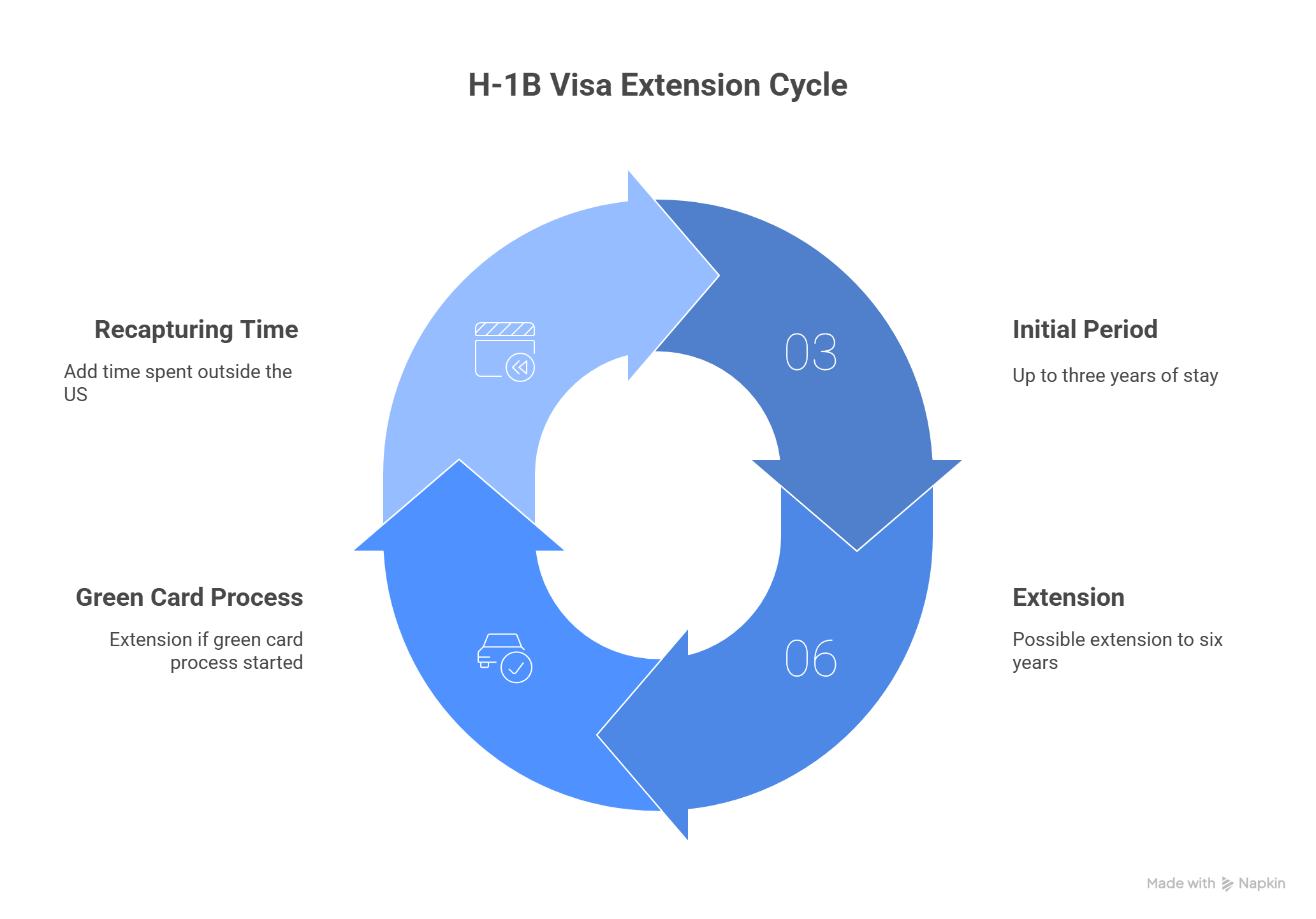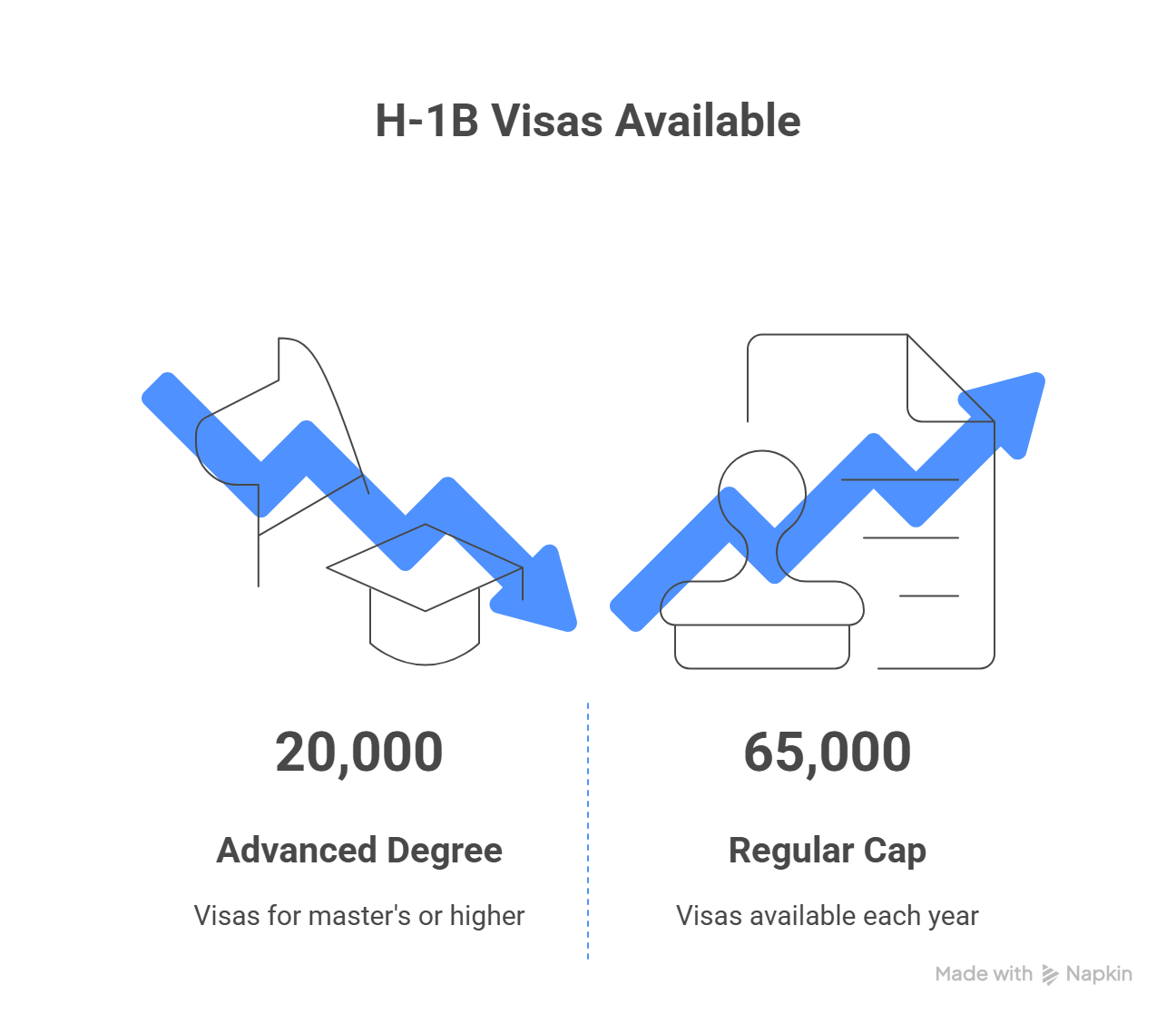--------- H-1B Visa Explained: Who Qualifies and What It Means to Be a Holder
Sep 5, 2025

If you’ve followed conversations around U.S. immigration, chances are you’ve come across the term H-1B visa. But what does it really mean to be an H-1B visa holder? Beyond the acronyms and legal jargon, the H-1B is one of the most talked-about—and sometimes controversial—visa categories in the U.S. immigration system. It represents a bridge between global talent and American opportunity, fueling industries from Silicon Valley to university research labs.
In this blog, we’ll break down what it means to hold an H-1B visa, why the program exists, and how it fits into the broader conversation about immigration and the U.S. workforce.
Brief Overview of the H-1B Visa Program
The H-1B visa is a non-immigrant visa that allows U.S. employers to hire foreign workers in “specialty occupations temporarily.” These roles require not just any skill set, but specialized knowledge—usually supported by at least a bachelor’s degree or its equivalent. Think software engineers, medical researchers, financial analysts, or university professors: professionals whose expertise is critical to innovation and growth.
For visa holders, the H-1B is both an opportunity to live and work in the United States and a potential stepping stone toward permanent residency. For U.S. employers, it’s a legal pathway to access global talent in fields where American workers are in short supply.
Why It Matters in Today’s U.S. Immigration and Labor Context
The H-1B program matters because it sits at the intersection of immigration policy, economics, and global competitiveness. On one hand, it fills labor shortages in industries like technology and healthcare that depend on highly skilled workers. On the other hand, it sparks debate about job opportunities for U.S. citizens, fair wages, and the role of immigration in shaping the economy.
With more demand than supply—the annual cap is quickly oversubscribed every year—the H-1B has become a symbol of both opportunity and challenge. Understanding what it means to be an H-1B visa holder provides insight into the broader dynamics of how the U.S. balances its labor needs with immigration law.
Definition and Legal Framework
What an H-1B Visa Holder Is
At its core, an H-1B visa holder is a foreign national approved to work in the United States in a specialty occupation for a specific employer. Their permission to work is temporary, tied to their sponsoring company, and grounded in the idea that their specialized skills bring value that the U.S. labor market alone cannot currently meet.
Legal Foundation Under the Immigration and Nationality Act (INA)
The legal basis for the H-1B visa lies in the Immigration and Nationality Act (INA), section 101(a)(15)(H)(i)(b). This section defines a specialty occupation as one that requires both “theoretical and practical application of a body of highly specialized knowledge” and at least a bachelor’s degree or its equivalent. In plain terms: these are jobs where deep expertise isn’t optional—it’s essential.
The program is administered by U.S. Citizenship and Immigration Services (USCIS) under the Department of Homeland Security, which oversees the petition process, employer compliance, and worker eligibility.
Historical Background: Creation in 1990 and the Purpose of the Program
The modern H-1B program was born with the Immigration Act of 1990, signed into law by President George H.W. Bush. Its purpose was straightforward yet ambitious: help American businesses stay competitive by addressing shortages in specialized fields through access to global talent.
In the decades since, the H-1B has become central to industries like tech, finance, medicine, and education. It remains a vital—if sometimes politically charged—tool for balancing U.S. labor needs with the realities of a global economy.
Key Characteristics of H-1B Visa Holders
The H-1B visa isn’t just a ticket to work in the U.S.—it comes with strict qualifications and rules. From education to employer sponsorship to job requirements, every piece is designed to ensure that only highly skilled professionals qualify.
Educational Requirements
At the foundation of the H-1B program is education. To qualify, applicants must hold at least a bachelor’s degree or its equivalent in a field directly related to the job they’re being hired for. But USCIS recognizes that not all paths to expertise look the same, so there are multiple ways to meet this requirement:
- U.S. degree: A bachelor’s degree or higher from an accredited U.S. institution.
- Foreign degree equivalency: A degree from abroad that has been evaluated and found equivalent to a U.S. bachelor’s degree.
- Work experience substitution: Using the “three-for-one” rule, where three years of specialized professional experience can stand in for one year of college education, allowing seasoned experts without traditional degrees to still qualify.
This flexibility ensures the program captures true expertise, whether it comes from classrooms, labs, or years of hands-on industry experience.
Employer Sponsorship
Unlike some visas, the H-1B is not self-petitioned. An aspiring H-1B worker must have a U.S. employer willing to sponsor them. The employer takes on significant responsibility in the process by filing Form I-129 (Petition for a Nonimmigrant Worker) with USCIS.
To succeed, the employer must demonstrate three key things:
- Legitimate job offer: The role is a bona fide specialty occupation.
- Wage compliance: The worker will be paid at least the higher of the prevailing wage for the occupation in that region or the actual wage paid to similarly situated employees.
- Labor protections: Hiring the foreign worker will not negatively impact the wages or working conditions of U.S. employees.
This sponsorship system ensures accountability—employers don’t just gain access to global talent, they must also protect the integrity of the U.S. labor market.
Specialty Occupation Criteria
The H-1B is built around the concept of the “specialty occupation.” Not every job qualifies; it must require advanced, specialized knowledge and skills. USCIS evaluates whether a position meets the criteria based on several standards:
- The role typically requires at least a bachelor’s degree as a minimum entry point.
- The degree requirement is standard in the industry, or the job is so unique and complex that only someone with specialized knowledge could perform it.
- The employer normally requires a degree for the position in question.
- The duties themselves are highly specialized and complex, making it impractical for someone without advanced education to carry them out.
In short, the specialty occupation test ensures that the H-1B program is reserved for roles where expertise isn’t optional—it’s essential.
Duration and Extensions
An H-1B visa is temporary by design, but it allows for a relatively long stay compared to other nonimmigrant categories.
- Initial period: Up to three years.
- Maximum stay: Extensions can bring the total to six years.
However, immigration law recognizes the reality of long-term employment and green card backlogs. That’s why there are exceptions that allow some H-1B holders to extend their stay beyond six years:
- Green card process: If the worker has an approved I-140 petition or a pending PERM labor certification, they may qualify for one-year extensions past the six-year limit until their green card is available.
- Recapturing time: Any time spent outside the United States during H-1B status can be “recaptured,” effectively adding those days or months back to the six-year total.
This balance—temporary yet renewable, capped but flexible—makes the H-1B a unique bridge between temporary work authorization and potential long-term residence.
Rights and Responsibilities
Being an H-1B visa holder comes with both protections and obligations. The program is structured to safeguard foreign workers while ensuring they respect the terms of their visa and U.S. law.
Rights of H-1B Visa Holders
Wage Protections
H-1B workers are entitled to fair pay. By law, employers must pay whichever is higher: the prevailing wage for the occupation in that geographic area or the actual wage paid to similar U.S. workers. This ensures that hiring foreign talent doesn’t undercut local wages or working conditions.
Dual Intent and Pathway to Green Card
Unlike many other visa categories, the H-1B allows dual intent. This means visa holders can maintain their temporary nonimmigrant status while also applying for permanent residency (a green card) without jeopardizing their visa. For many professionals, the H-1B serves as the first step toward building a permanent life in the U.S.
Work Restrictions and Grace Periods
H-1B status is tied to the sponsoring employer and the specific role approved by USCIS. However, workers aren’t left stranded if employment ends. They are granted a 60-day grace period to find a new sponsor, change visa status, or make departure arrangements—an important safety net in times of career transition.
Responsibilities of H-1B Visa Holders
Maintaining Lawful Status
H-1B holders must continue working for the employer that sponsored their petition. Unauthorized employment, even briefly, can lead to loss of status.
Compliance with Job and Location Restrictions
The visa is specific to the position and work location listed in the petition. Significant changes—like moving to a new office in another city or taking on different job duties—require updated filings with USCIS.
Tax and Legal Obligations
As temporary U.S. residents, H-1B workers must file taxes, comply with U.S. laws, and report any material changes in their employment. Remaining compliant ensures they keep their lawful status and maintain eligibility for future benefits, such as green card sponsorship.
Annual Cap and Lottery System
The H-1B program is in high demand, which is why it operates under a strict numerical cap set by Congress.
Regular Cap and Advanced Degree Exemption
- 65,000 visas are available each fiscal year under the regular cap.
- An additional 20,000 visas are set aside for applicants with U.S. master’s degrees or higher, giving advanced degree holders an extra chance at selection.
- Due to treaty obligations, a small portion of the regular cap is reserved for nationals of Chile and Singapore.
Electronic Registration System and Selection Odds
Since 2020, USCIS has used an electronic pre-registration system. Employers submit registrations for their intended H-1B hires, and if the number of registrations exceeds the cap (as it almost always does), a random lottery determines who gets to file a full petition.
FY2026 Statistics to Illustrate Demand
For the 2026 fiscal year, the numbers tell the story of demand versus supply:
- 336,153 unique beneficiaries registered for the H-1B lottery.
- Only 118,660 were selected, translating to a 35.3% selection rate.
These figures highlight both the intense competition and the limited availability of H-1B visas, underscoring why the program remains a focal point of immigration policy and reform debates.
Common Occupations for H-1B Workers
H-1B visa holders aren’t concentrated in just one industry—they span a wide range of professions that rely on highly specialized skills. Still, a few sectors dominate the landscape.
Technology and Engineering Roles
The tech industry is the single largest employer of H-1B workers. Roles include:
- Software engineers and developers
- Computer scientists and systems analysts
- IT specialists and network architects
These professionals often drive innovation in fields like cloud computing, cybersecurity, and artificial intelligence.
Healthcare Professionals
The U.S. healthcare system frequently turns to H-1B workers to address critical shortages. Common roles include:
- Physicians and surgeons
- Nurses and other healthcare practitioners
- Psychologists and mental health specialists
In many communities, H-1B professionals are essential in filling gaps where U.S. supply of trained professionals is limited.
Business and Finance Occupations
Beyond tech and healthcare, H-1B visas also support the business world. Common positions include:
- Financial analysts and accountants
- Management consultants
- Market research analysts
These professionals bring global perspectives to U.S. companies navigating international markets.
Education, Research, and Other Professions
Universities and research institutions also rely on H-1B workers for teaching and discovery. Roles include:
- Professors and lecturers
- Teachers in specialized subjects
- Research scientists conducting cutting-edge work
Additionally, H-1B visas are used in fields such as architecture, law, and journalism—sectors that also benefit from highly trained specialists.
Comparison with Other U.S. Work Visas
The H-1B isn’t the only pathway for foreign professionals to work in the United States. To understand its unique place in the immigration system, it helps to compare it to other visa categories.
H-1B vs L-1: New Hire vs Intracompany Transfer
- H-1B: Designed for new hires in specialty occupations. A U.S. employer sponsors a foreign professional to fill a specific role.
- L-1: Intended for intracompany transfers, moving existing employees from a company’s foreign office to a U.S. branch.
H-1B vs O-1: Degree Requirement vs Extraordinary Ability
- H-1B: Requires at least a bachelor’s degree (or equivalent) in a specialty field.
- O-1: Focused on individuals with extraordinary ability or achievement in fields like science, the arts, business, or athletics—think top-tier researchers, award-winning artists, or elite athletes.
H-1B vs TN: Broader Coverage vs NAFTA-Specific Roles
- H-1B: Available to professionals worldwide, covering a wide variety of occupations.
- TN: Limited to Canadian and Mexican citizens under the United States-Mexico-Canada Agreement (USMCA, formerly NAFTA) and restricted to a specific list of professional roles.
Each of these visa categories serves a different purpose, but the H-1B remains the most widely recognized option for foreign professionals seeking to bring their specialized expertise to the U.S.
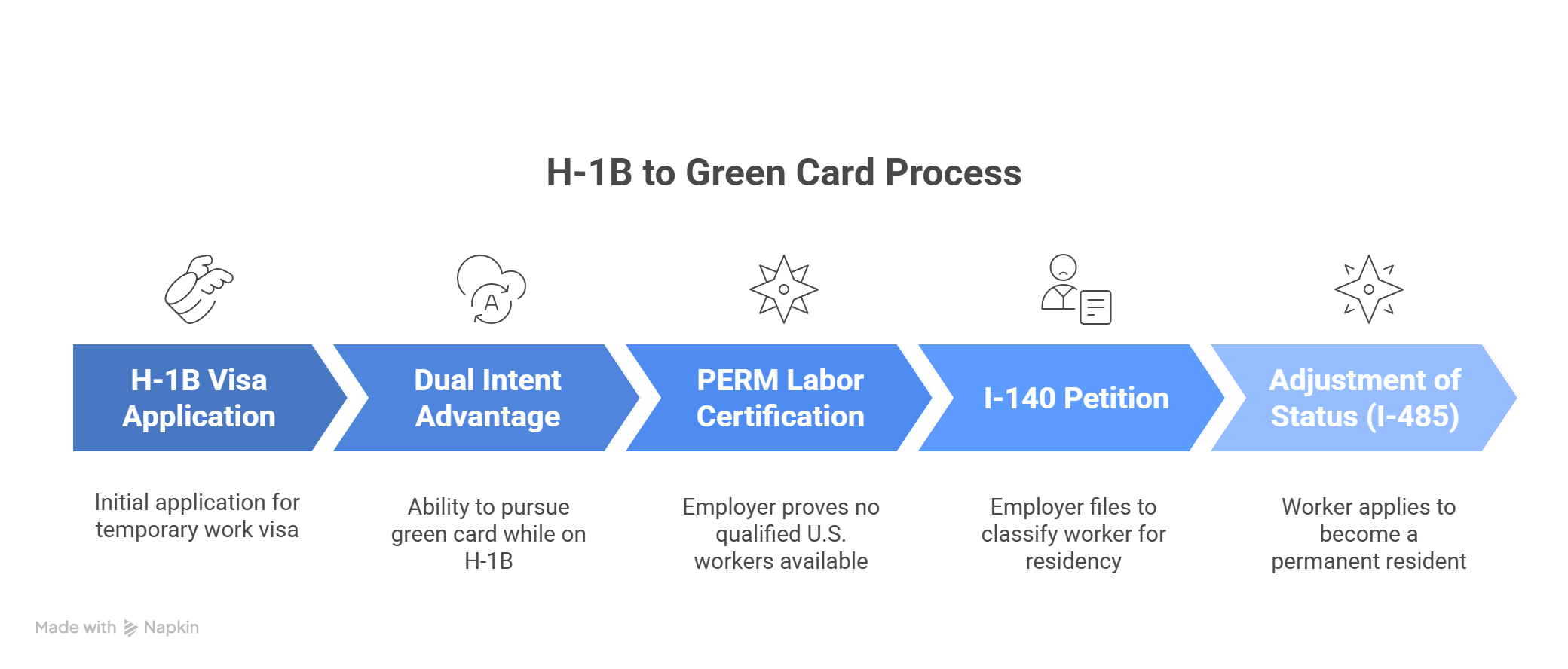
Path to Permanent Residency
One of the defining features of the H-1B visa is its dual intent advantage. Unlike many temporary visas that prohibit long-term immigration plans, the H-1B allows workers to maintain nonimmigrant status while actively pursuing a green card. This flexibility makes it a practical stepping stone toward permanent residency in the U.S.
Dual Intent Advantage
H-1B holders don’t have to choose between temporary work and long-term settlement. They can work under H-1B status while simultaneously applying for permanent residency without jeopardizing their legal standing. This “dual intent” design acknowledges the reality that many foreign professionals aim to transition from temporary to permanent roles in the U.S. economy.
Common Green Card Pathways for H-1B Holders
Most H-1B workers pursue employer-sponsored green cards through the employment-based categories (EB-2 or EB-3). The process often involves:
- PERM Labor Certification: Employer proves no qualified U.S. workers are available for the job.
- I-140 Petition: Employer files to classify the worker as eligible for permanent residency.
- Adjustment of Status (I-485): Worker applies to become a lawful permanent resident once a green card number is available.
This pathway can take years due to visa backlogs, but it remains the most common route for H-1B professionals aiming to make the U.S. their permanent home.
Recent Developments and Policy Changes
The H-1B program continues to evolve, with reforms designed to strengthen fairness, reduce fraud, and modernize access.
Beneficiary-Centric Lottery System (2025)
In 2025, USCIS introduced a beneficiary-centric lottery, shifting selection from employer registrations to individual applicants. This prevents multiple employers from flooding the system with duplicate entries for the same worker, ensuring a fairer and more transparent lottery process.
Domestic Renewal Pilot Program
A new pilot program allows certain H-1B visa holders to renew their visas within the U.S. instead of traveling abroad for consular processing. This change reduces disruption for workers and employers alike, making the renewal process more convenient and efficient.
Modernization Initiatives for Entrepreneurs and Startups
Recent rules have also opened the door for entrepreneurs and startup founders to access H-1B visas more easily. By broadening definitions and criteria, USCIS is encouraging innovation and supporting the growth of new businesses driven by global talent.
Conclusion
The H-1B visa is more than just paperwork—it’s a gateway for global talent to contribute to the U.S. economy in meaningful ways. H-1B visa holders are skilled professionals who bring specialized knowledge to industries like technology, healthcare, finance, and education.
They play a vital role in shaping innovation, strengthening industries, and bridging U.S. labor gaps. At the same time, the H-1B program reflects broader debates about immigration policy, economic competitiveness, and the balance between protecting American workers and embracing global expertise.
In the end, an H-1B visa holder isn’t just a temporary guest worker—they’re part of the ongoing story of how the U.S. economy adapts, evolves, and thrives in a globalized world.
Frequently Asked Questions (FAQ)
1. Who is eligible for an H-1B visa?
Eligibility requires a job offer in a specialty occupation, at least a bachelor’s degree (or its equivalent), and a U.S. employer willing to sponsor the visa through a formal petition.
2. How long can someone stay in the U.S. on an H-1B visa?
H-1B status is initially granted for up to three years, with the possibility of extensions up to a maximum of six years. Certain exceptions allow for additional extensions if the worker is in the process of obtaining permanent residency.
3. Can H-1B visa holders apply for a green card?
Yes. The H-1B is a “dual intent” visa, meaning holders can work temporarily while pursuing permanent residency. Most follow employer-sponsored green card pathways through the EB-2 or EB-3 categories.
4. What happens if an H-1B worker loses their job?
H-1B visa holders have a 60-day grace period to find a new sponsoring employer, change their visa status, or make plans to depart the U.S.
5. Why is the H-1B lottery system used?
Because demand far exceeds the annual cap of 85,000 visas, USCIS uses an electronic lottery to randomly select eligible beneficiaries. In FY2026, only about 35% of registrants were chosen to proceed.
Recent Articles
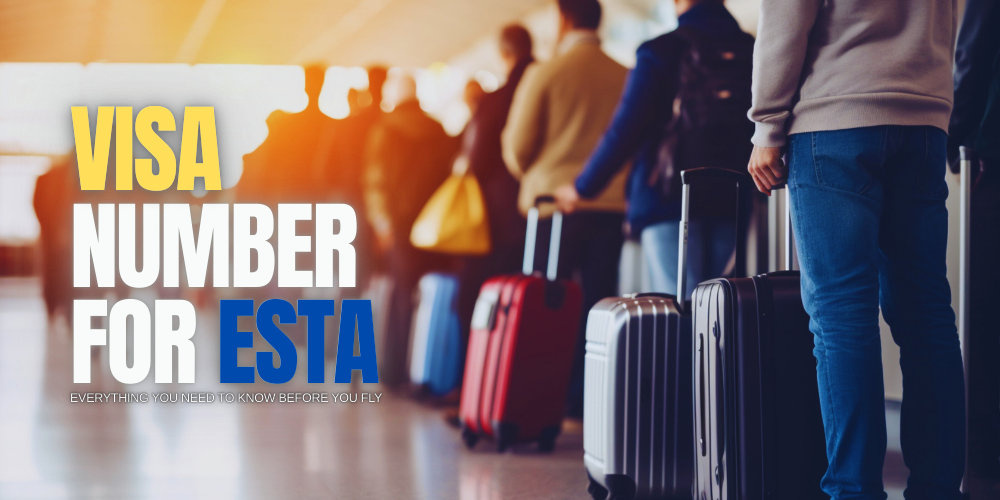
Visa Number for ESTA: Everything You Need to Know Before You Fly
If you’ve ever tried to check in online for a U.S.-bound flight and been met with that dreaded box
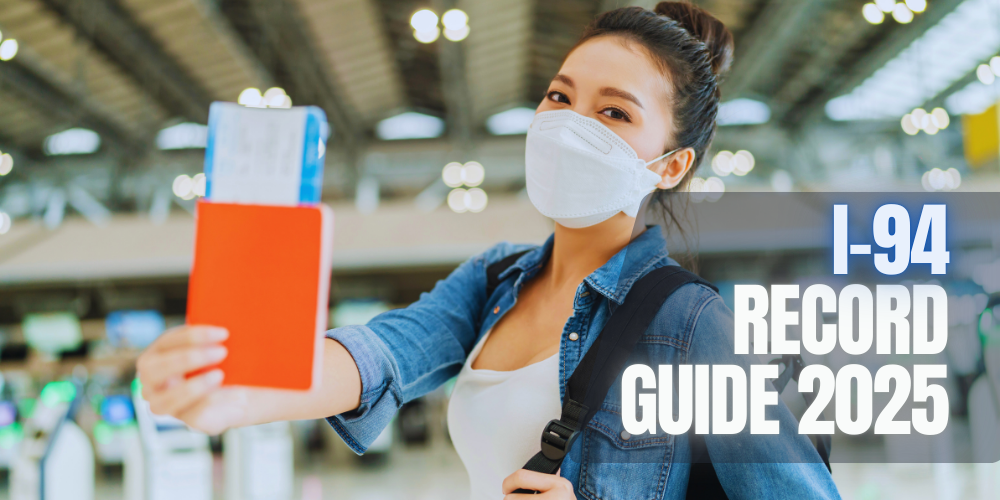
I-94 Record Guide 2025: How to Get, Retrieve, and Fix Your Arrival/Departure Record
If U.S. immigration were a novel, the I-94 would be the quiet supporting character who turns out to

H-1B to H-4 Change of Status: The Complete 2025 Guide (Processing Times, Requirements & EAD Eligibility)
Transitioning from H-1B to H-4 status isn’t just a bureaucratic shuffle—it’s a strategic shift

How Long Does a TN Visa Extension Take in 2025?
Time — it’s the one thing every TN professional learns to respect. Whether you’re an engi
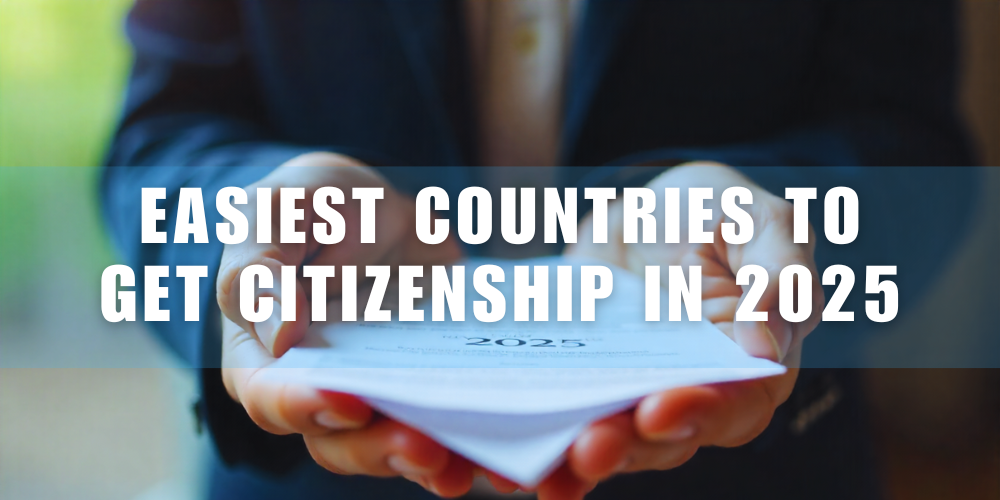
The Easiest Countries to Get Citizenship in 2025: Fast Tracks, Smart Moves, and Hidden Shortcuts
In 2025, the idea of belonging to just one nation feels almost quaint. As the world continues to shr
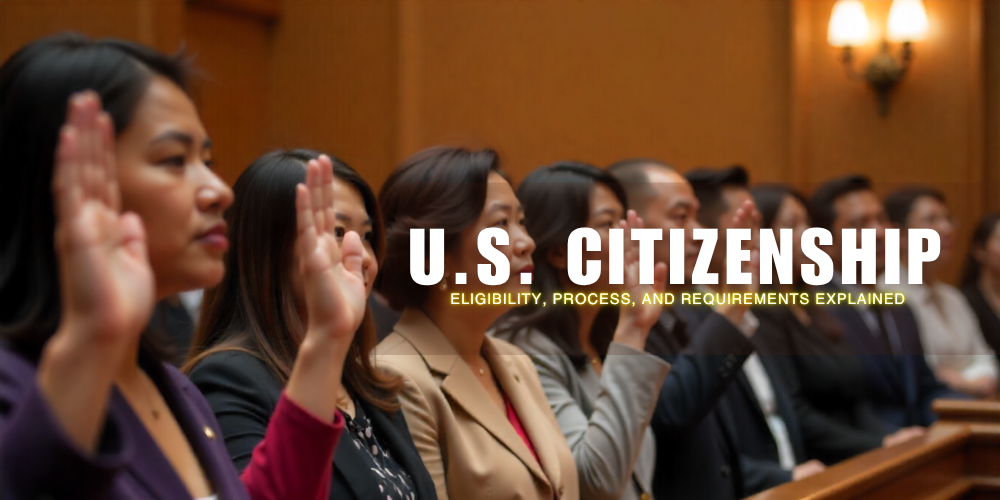
U.S. Citizenship Made Simple: Eligibility, Process, and Requirements Explained
For many, U.S. citizenship is more than just a passport—it’s a gateway to stability, opportunity
Read More

Visa Number for ESTA: Everything You Need to Know Before You Fly

I-94 Record Guide 2025: How to Get, Retrieve, and Fix Your Arrival/Departure Record

H-1B to H-4 Change of Status: The Complete 2025 Guide (Processing Times, Requirements & EAD Eligibility)

How Long Does a TN Visa Extension Take in 2025?

The Easiest Countries to Get Citizenship in 2025: Fast Tracks, Smart Moves, and Hidden Shortcuts

U.S. Citizenship Made Simple: Eligibility, Process, and Requirements Explained

Welcome to the VisaTravel blog. We know that navigating the maze of visa applications and online forms can be as tricky as choosing the perfect travel playlist (which is all we want you worrying about anyway).
Throughout our years of experience, though, we’ve uncovered a mountain of knowledge which, via this blog, we’re sharing with you! Whether you're diving into the world of travel visas, wondering about the ESTA online hustle, or just trying to figure out the DS160 form, think of us as your online concierge, here to make the process easy and most of all, clear.
At this point in our global context, who has time for endless paperwork and confusing legal jargon? No one. That's why we're all about spilling the tea on online visa hacks, easier-to-work-with DS160 forms, and giving you tips on everything from tourist visas to immigration, to that last-minute ESTA online adventure.
So, just plug in a word you’re curious about on the search bar, and boom. We've got the tips, tricks, and insider info to help you (and anyone else you may be traveling with) get to your travel destination with the confidence of a seasoned traveler.
Now go explore!
 U.S. Visa
U.S. Visa
 Canada eTA
Canada eTA
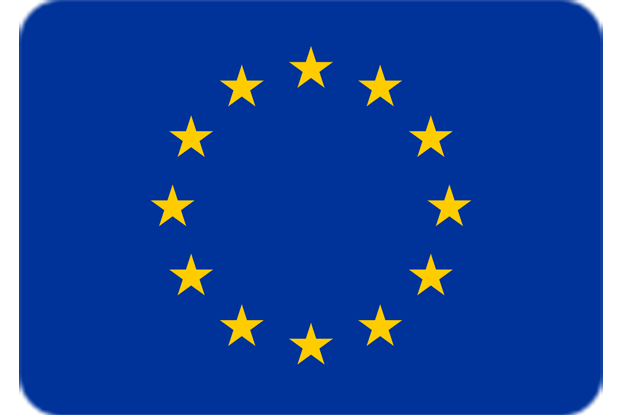 Schengen Visa
Schengen Visa
 New Zealand eTA
New Zealand eTA
 United Kingdom eTA
United Kingdom eTA
 Australia eVisitor
Australia eVisitor
 Vietnam eVisa
Vietnam eVisa
 Egypt eVisa
Egypt eVisa
 Singapore Arrival Card
Singapore Arrival Card
 Sri Lanka eVisa
Sri Lanka eVisa




